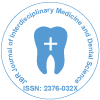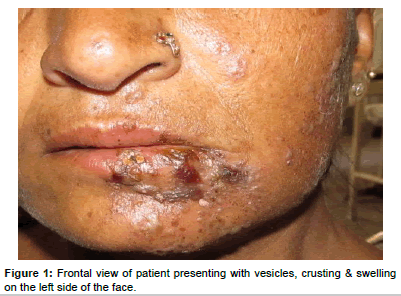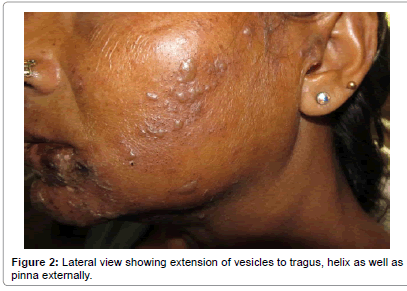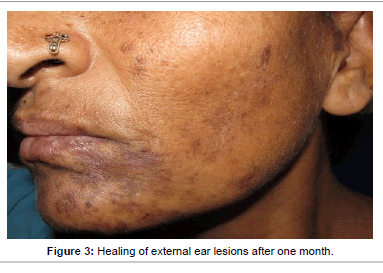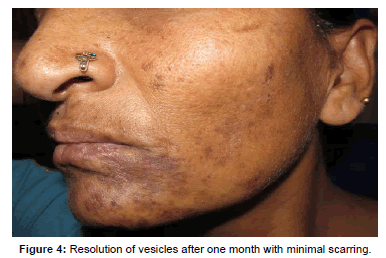Case Report Open Access
Clinical Management of Ramsay Hunt Syndrome ? A Case Report
Navjot Singh2, Rajesh Gera1, Rosy Arora3 and Archna Agnihotri4*
1SMO Civil Hospital, Naraingarh, India
2MO Civil Hospital, Naraingarh, India
3Department of Public health dentistry, Panjab University, India
4Department of Pedodontics, Panjab University, India
- Corresponding Author:
- Archna Agnihotri
Dr Harvansh Singh Judge Institute Of Dental Sciences
Panjab University, Chandigarh, India
Tel: +91-9501093618
E-mail: archna.agnihotri@gmail.com
Received date July 25, 2014; Accepted date September 11, 2014; Published date Septemebr 17, 2014
Citation: Singh N, Gera R, Arora R, Agnihotri A. (2014) Clinical Management of Ramsay Hunt Syndrome – A Case Report. J Interdiscipl Med Dent Sci 2:151. doi: 10.4172/2376-032X.1000151
Copyright: © 2014 Singh N, et al. This is an open-access article distributed under the terms of the Creative Commons Attribution License, which permits unrestricted use, distribution, and reproduction in any medium, provided the original author and source are credited.
Visit for more related articles at JBR Journal of Interdisciplinary Medicine and Dental Science
Abstract
Unilateral facial palsy with vesicle formation in the distribution of the fifth seventh eighth ninth or tenth cranial nerve as well as severe facial pain are suggestive of the Ramsay Hunt Syndrome due to Varicella Zoster virus reactivation. We present a case of RHS and its clinical management so as to increase the chances of complete recovery.
Keywords
Unilateral facial palsy; Vesicles; Facial pain; Ramsay hunt syndrome
Introduction
Ramsay Hunt Syndrome (RHS) also known as Geniculate ganglion herpes or otic zoster is characterized by ipsilateral facial palsy and herpes zoster features of auricle, external auditory canal and tympanic membrane and is often accompanied by neurological symptoms of the inner ear. The clinical presentation is in the form of fever, tinnitus, hyperacusis, otalgia, sensorineural hearing loss, vertigo, painful skin vesicles, ageusia in the ipsilateral anterior tongue & nystagmus [1].
It is caused by reactivation of a previous Varicella zoster virus (VZV) infection and accounts for 12% of all facial nerve palsies [2]. VZV after the initial infection is found to reside in the spinal nerve ganglia or in cranial nerve ganglia of the fifth, seventh, eighth, ninth or tenth cranial nerve [3]. The latency is life long and Herpes Zoster (HZ) is caused by viral reactivation from latent state. The Center for Disease control estimates that 32% of people in the USA will have HZ during their lifetime [4]. However, RHS has a much lower incidence, presenting in only 0.2% of all HZ cases [5,6].
The aim of this article is to discuss about the clinical presentation and management of RHS so as to facilitate timely diagnosis, treatment and ensure favourable recovery.
Case Report
A 45 year old female reported with fever accompanied by severe pain and rash on the left side of the face. The detailed history revealed that the onset of symptoms started a week back beginning with fever and preauricular pain which was followed by vesicle formation on the left side of the face extending to the tragus, helix & pinna of ear externally and buccal mucosa and palate in the oral cavity (Figure 1and 2). Patient also exhibited facial nerve palsy with drooping of the corner of the mouth on the left side and a difficulty in hearing on the same side. There was no other significant medical history. The patient was admitted to the hospital as she had high grade fever and was in severe pain. IV fluids and analgesic therapy was started along with definitive antiviral therapy with acyclovir 800 mg five times a day for seven days as well as systemic steroid therapy with prednisolone 60 mg for 7 days which was gradually tapered off. Patient showed a definite improvement by two weeks with only dysesthesia and tingling sensation in the region of the buccal branch of the marginal mandibular nerve. The patient was discharged and put on a monthly recall (Figure 3and 4). After one month all the symptoms had subsided and the patient could smile symmetrically.
Discussion
Varicella typically occurs during childhood in temperate climates and during adolescence or early adulthood in tropical areas [7]. The Varicella Zoster Virus belongs to the Herpes viridae family. Primary VZV infection produces chickenpox after which the virus becomes latent in neurons of cranial nerve ganglia such as the geniculate ganglion as well as the dorsal root ganglion along the entire neural axis. RHS is caused by the reactivation the latent VZV. The risk factors associated with viral reactivation include increasing age, various diseases (HIV infection and certain malignancies) and immunocompromised disease states [8]. The symptoms of RHS which include facial palsy, vesicle formation are seen due to underlying neural inflammation, pressure which causes a neuropraxia when the reactivated VZV replicates within and travels along the axons of the involved dermatome [9]. Reactivation leads to inflammation and edema of the sensory fibers as well as the closely related motor fibers resulting in paresis [10]. In this case report the sensory fibers of the geniculate ganglion as well as maxillary division of the trigeminal nerve were affected due to the reactivation.
The diagnosis of Ramsay Hunt Syndrome is based on the triad of symptoms which include facial paralysis, ear pain & herpetic eruptions in any cranial dermatome [11]. The diagnostic triad of RHS cannot be applied to atypical forms which may present with multiple nerve involvement or absence of skin lesions. The gold standard for diagnosing VZV reactivation is polymerase chain reaction of skin, saliva or middle ear fluid samples but this is rarely done clinically [12].
The complications of RHS [13] include :
1. Corneal abrasions and ulcers, if eye-lid closure is impaired
2. Secondary infection with bacteria (cellulitis)
3. Postherpetic neuralgia, as with other Varicella Zoster virus reactivations
4. Permanent facial paralysis
5. Long term ipsilateral hearing loss and tinnitus
The main line drugs in the management of RHS include Antivirals and corticosteroids. Cases where Acyclovir & prednisone therapy is started within three days of onset of symptoms have 70% -86% chances of full recovery in comparison to only 20% in patients receiving no treatment [14]. In addition, 50% of patients who are not treated in the first 3 days may have a complete loss of response to facial nerve stimulation. Acyclovir is the drug of choice for VZV infections & its mode of action is activation of acyclovir to acyclovir triphosphate by viral thymidine kinase. This acyclovir triphosphate inhibits viral DNA polymerase and thus DNA replication [15]. It has been shown that acyclovir therapy results in improvement in facial paresis & nerve function as measured by nerve excitability testing [16]. Although still rare increasing resistance to acyclovir therapy has been reported and newer drugs such as valacyclovir, famciclovir, penciclovir & brivudine are being used [17]. Immunocompromised patients are generally given IV Acyclovir although no statistically significant difference among treated patients exists between oral and IV Acyclovir [18].
The use of corticosterids for treatment of RHS is debatable. Large Randomised Contolled Trials (RCT) showed that adjunct corticosteroids resulted in quicker healing of the rash and decreased incidence and severity of pain during HZ. At the same time, no reduction in the incidence or severity of post herpetic neuralgia was observed in these studies [8,19]. Recently, studies have advocated the use of high dose steroids for the treatment. Finsterer et al have suggested the use of dexamethasone over prednisolone as it has higher antiedematous effect and thus better nerve recovery compared to latter [20]. Another Cochrane Review of the sole RCT which compared treatment with antivirals and corticosteroids to corticosteroids alone in 15 RHS patients showed no significant difference in outcomes [21]. Some authors also caution against implementing steroid therapy, especially in periocular lesions which may lead to dissemination of the VZV infection [22,23].
There has been a paucity of data regarding the management of RHS, but considering the possibility of lifelong facial paralysis and hearing loss, experts recommend combination antiviral and corticosteroid therapy within the first 72 hours of symptoms [1,24]. Though no setdosing regimen exists, 800 mg acyclovir 5 times/day for 7–10 days and Prednisone 1 mg/kg for 5 days and taper has been used in published trials [13]. Microvascular decompression & rhizotomy are therapeutic options reserved for resistant neuralgias [22,25]. Supportive measures in the form of Eye patches, taping the eye closed, artificial tears and oral analgesics are also used in the management of RHS.
RHS can be seen in a spectrum of variations, which may be in the form of multiple nerve involvement or facial swellings that appear to be of odontogenic origin [26]. Close patient follow-up, prompt diagnosis, early antiviral and steroid therapy and periodic follow up are essential to ensure early and favorable recovery.
References
- Sweeney CJ, Gilden DH (2001) Ramsay Hunt syndrome.J NeurolNeurosurg Psychiatry 71: 149-154.
- Robillard RB, Hilsinger RL Jr, Adour KK (1986) Ramsay Hunt facial paralysis: clinical analyses of 185 patients.Otolaryngol Head Neck Surg 95: 292-297.
- Hiroshige K, Ikeda M, Hondo R (2002) Detection of varicella zoster virus DNA in tear fluid and saliva of patients with Ramsay Hunt syndrome. OtolNeurotol 23:602–607
- Harpaz R, Ortega-Sanchez IR, Seward JF; Advisory Committee on Immunization Practices (ACIP) Centers for Disease Control and Prevention (CDC) (2008) Prevention of herpes zoster: recommendations of the Advisory Committee on Immunization Practices (ACIP).MMWR Recomm Rep 57: 1-30.
- Galil K, Choo PW, Donahue JG, Platt R (1997) Thesequelae of herpes zoster.Arch Intern Med 157: 1209-1213.
- Yawn BP, Saddier P, Wollan PC, St Sauver JL, Kurland MJ, et al. (2007) A population-based study of the incidence and complication rates of herpes zoster before zoster vaccine introduction.Mayo ClinProc 82: 1341-1349.
- Seward J (2000) Epidemiology of Varicella.In : Arvin AM, Gershon AA Varicella-Zoster Virus: Virology and clinical management. Cambridge University Press, Cambridge, UK: 187-205.
- Dworkin RH, Johnson RW, Breuer J, Gnann JW, Levin MJ, et al. (2007) Recommendations for the management of herpes zoster.Clin Infect Dis 44 Suppl 1: S1-26.
- Sobn AJ, Tranmer PA (2001) Ramsay Hunt syndrome in a patient with human immunodeficiency virus infection.J Am Board FamPract 14: 392-394.
- Kuhweide R1, Van de Steene V, Vlaminck S, Casselman JW (2002) Ramsay Hunt syndrome: pathophysiology of cochleovestibular symptoms.J LaryngolOtol 116: 844-848.
- Hunt JR (1907)On herpetic inflammations of the geniculate ganglion: a new syndrome and its complications. J NervMent Dis34:73–96.
- Andrei G, Sienaert R, McGuigan C, Clercq ED, Balzarini J, Snoeck R (2005)Susceptabilities of several clinical varicella-zoster virus (VZV) isolates and drug resistant VZV strains to bicyclic furano pyrimidine nucleosides. Antimicrob Agents Chemother 49: 1081–1086.
- Worme M, Chada R, Lavallee L (2013) An unexpected case of Ramsay Hunt syndrome: case report and literature review.BMC Res Notes 6: 337.
- Aizawa H, Ohtani F, Furuta Y, Sawa H, Fukuda S (2004) Variable patterns of varicella-zoster virus reactivation in Ramsay Hunt syndrome.J Med Virol 74: 355-360.
- Dorsky DI, Crumpacker CS (1987) Drugs five years later: acyclovir.Ann Intern Med 107: 859-874.
- Kinishi M, Amatsu M, Mohri M, Saito M, Hasegawa T, et al. (2001) Acyclovir improves recovery rate of facial nerve palsy in Ramsay Hunt syndrome.AurisNasus Larynx 28: 223-226.
- Andrei G, Sienaert R, McGuigan C, Clercq ED, Balzarini J, Snoeck R (2005)Susceptabilities of several clinical varicella-zoster virus (VZV) isolates and drug resistant VZV strains to bicyclic furano pyrimidine nucleosides. Antimicrob Agents Chemother 49:1081–1086.
- Drew WL, Buhles W, Erlich KS (1988) Herpesvirus infections (cytomegalovirus, herpes simplex virus, varicella-zoster virus). How to use ganciclovir (DHPG) and acyclovir.Infect Dis Clin North Am 2: 495-509.
- Wood MJ, Johnson RW, McKendrick MW, Taylor J, Mandal BK, et al. (1994) A randomized trial of acyclovir for 7 days or 21 days with and without prednisolone for treatment of acute herpes zoster.N Engl J Med 330: 896-900.
- Finsterer J, Bachtiar A, Niedermayr A (2012) Favorable Outcome of Ramsay Hunt Syndrome under Dexamethasone.Case Rep Med 2012: 247598.
- Uscategui T, Dorée C, Chamberlain IJ, Burton MJ (2008) Antiviral therapy for Ramsay hunt syndrome (herpes zoster oticus with facial palsy) in adults. Cochrane Database Syst Rev 8:1–2.
- Van de Steene V, Kuhweide R, Vlaminck S, Casselman J (2004) Varicella zoster virus: beyond facial paralysis.ActaOtorhinolaryngolBelg 58: 61-66.
- Hill G, Chauvenet AR, Lovato J, McLean TW (2005) Recent steroid therapy increases severity of varicella infections in children with acute lymphoblastic leukemia.Pediatrics 116: e525-529.
- Murakami S, Honda N, Mizobuchi M, Nakashiro Y, Hato N, et al. (1998) Rapid diagnosis of varicella zoster virus infection in acute facial palsy.Neurology 51: 1202-1205.
- Rupa V, Saunders RL, Weider DJ (1991) Geniculate neuralgia: the surgical management of primary otalgia.J Neurosurg 75: 505-511.
- Jan AM, McGuire TP, Clokie CM, Sándor GK (2006) Unilateral facial swelling caused by Ramsay Hunt syndrome resembles odontogenic infection.J Can Dent Assoc 72: 829-832.
Relevant Topics
- Cementogenesis
- Coronal Fractures
- Dental Debonding
- Dental Fear
- Dental Implant
- Dental Malocclusion
- Dental Pulp Capping
- Dental Radiography
- Dental Science
- Dental Surgery
- Dental Trauma
- Dentistry
- Emergency Dental Care
- Forensic Dentistry
- Laser Dentistry
- Leukoplakia
- Occlusion
- Oral Cancer
- Oral Precancer
- Osseointegration
- Pulpotomy
- Tooth Replantation
Recommended Journals
Article Tools
Article Usage
- Total views: 16152
- [From(publication date):
December-2014 - Jul 02, 2025] - Breakdown by view type
- HTML page views : 11483
- PDF downloads : 4669
